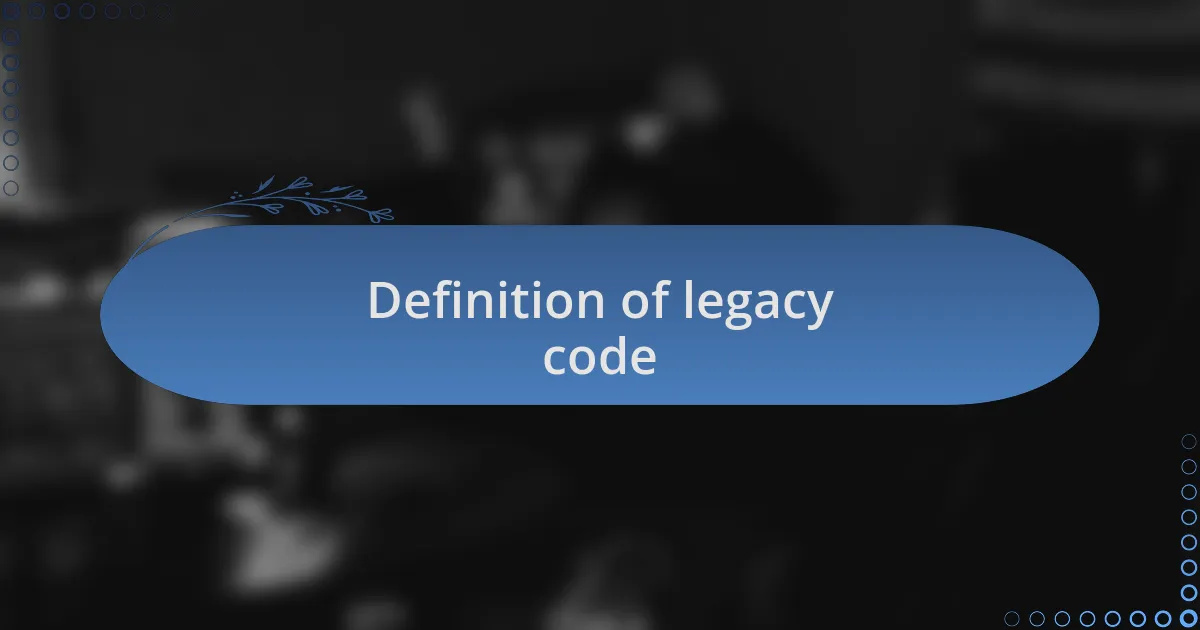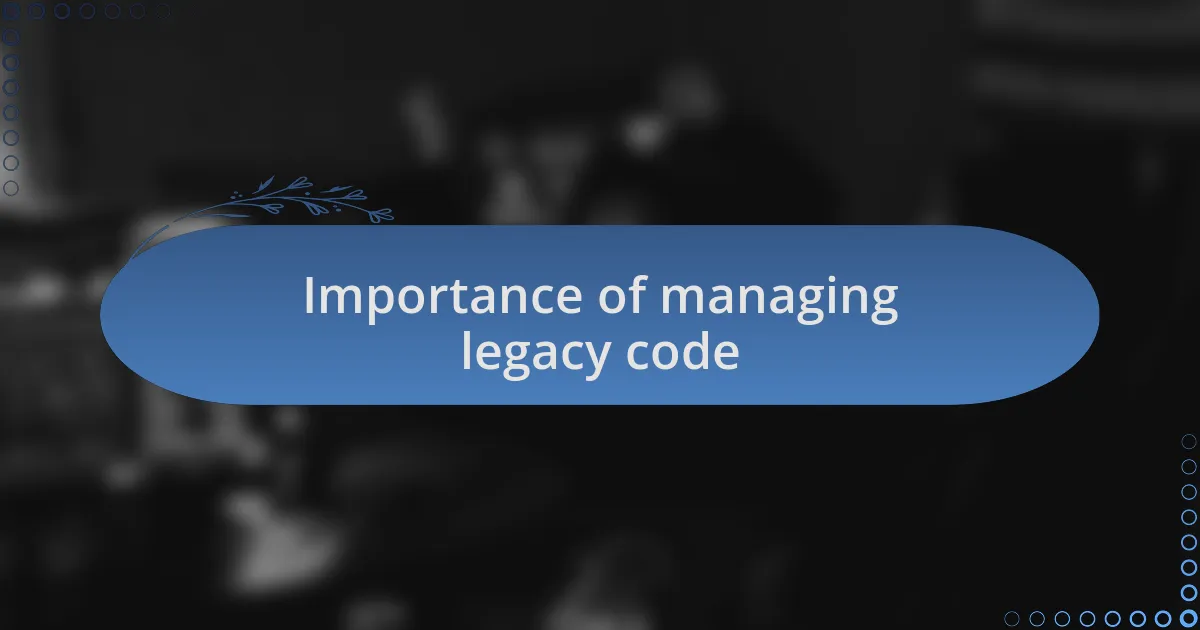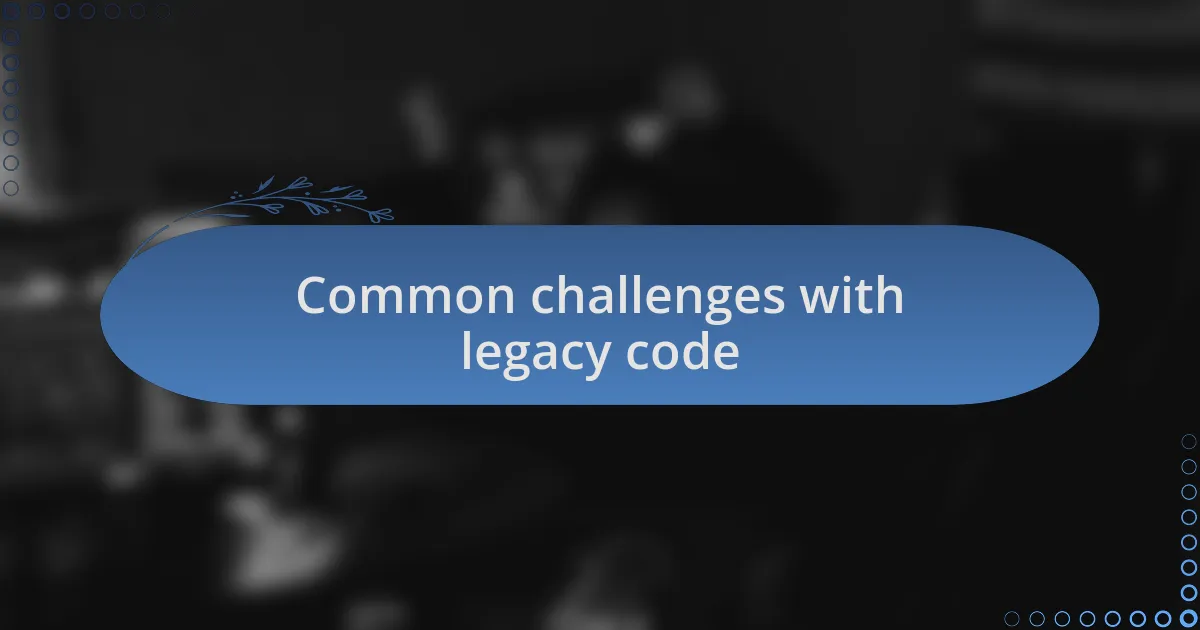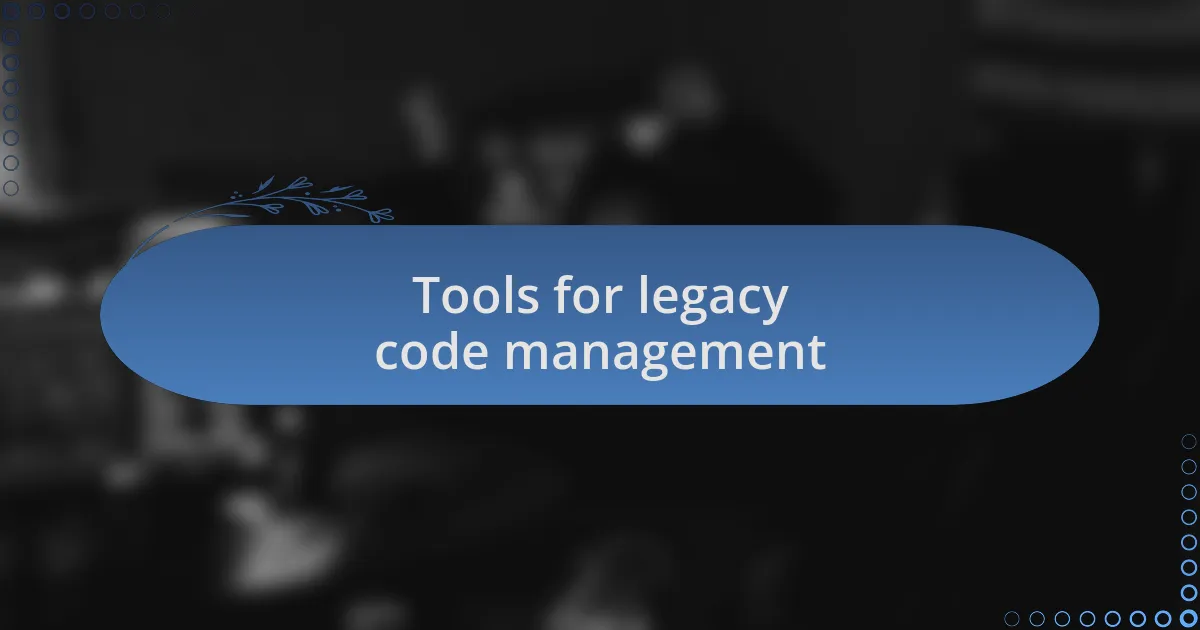Key takeaways:
- Legacy code is outdated software that is crucial for operations but often lacks documentation, making it difficult to maintain and understand.
- Effective management of legacy code is essential for operational efficiency, security, and fostering innovation within development teams.
- Challenges include understanding complex code, lack of documentation, and the difficulty of integrating with modern technologies.
- Tools like version control systems, code linters, and automated testing frameworks are vital for managing and improving legacy code effectively.

Definition of legacy code
Legacy code refers to software that is outdated or no longer actively maintained, but still plays a critical role in an organization’s operations. It’s often written in older programming languages or frameworks, which can make it challenging to work with. I remember a project where I had to dive into a legacy codebase; it felt like stepping into a time capsule, and it was both daunting and fascinating.
In my experience, legacy code can carry a weight of emotional resistance, especially when developers encounter it for the first time. You might find yourself wondering, “How did we end up here?” It’s a reminder of both the accomplishments and the hurdles faced by teams before you. Sometimes, these codes serve as a historical artifact of the company’s development journey, capturing the intent and effort of those who came before.
Furthermore, legacy code often lacks proper documentation, complicating the code maintenance process. Without clear explanations, it’s like trying to read a book in a foreign language. Have you ever spent hours unraveling someone else’s logic? That mix of frustration and curiosity can be quite a humbling experience, teaching you a lot about software development and the importance of writing clear, maintainable code.

Importance of managing legacy code
Managing legacy code is crucial for several reasons, and one of the most significant is maintaining operational efficiency. I once worked on an application that relied heavily on legacy code. Every update or new feature felt like navigating a maze, and it quickly became clear that ignoring the code’s intricacies could lead to severe setbacks. I realized that a proactive approach to managing this code was essential; otherwise, we’d risk creating a bottleneck in our development process.
Another important aspect is understanding the risks associated with legacy code. These systems can be riddled with vulnerabilities, posing security threats that many organizations overlook. It was a wake-up call for me when I discovered a hidden security flaw in a legacy application. This experience taught me that regular assessments and updates aren’t just beneficial; they’re necessary to protect the integrity of the entire system.
Finally, effectively managing legacy code fosters a culture of innovation. When we streamline outdated systems, it opens the door for new ideas and technologies. I recall how revitalizing that old codebase allowed my team to integrate modern features seamlessly, enhancing both functionality and user experience. It becomes evident that treating legacy code as a valuable asset rather than a burden can lead to growth and improvement in the long run.

Common challenges with legacy code
One of the most common challenges with legacy code is the sheer difficulty of understanding it. I remember diving into an ancient PHP codebase where variable names seemed like they were written in a foreign language. This experience made me wonder: how can we expect developers to work efficiently when they can’t even decipher the code? It’s like trying to read a book in a dialect you’ve never learned; frustration is inevitable.
Another significant issue is the lack of documentation. I once took over a project where the original developer had left no trail behind. It felt like embarking on an archaeological dig without any maps or clues. This lack of guidance meant that not only did I spend valuable time figuring out the code’s structure, but I also risked introducing errors while trying to implement new features. How often do teams assume that documentation will just appear magically? Too often, I learned.
Lastly, integrating legacy code with modern technologies is a constant uphill battle. There was a situation where I had to integrate a legacy application with a new cloud service. The mismatch in protocols and data formats made it feel like I was trying to fit a square peg into a round hole. It raised the question: at what point do we decide it’s more efficient to rewrite the code rather than patch it? Navigating these challenges requires careful consideration and strategy to find an effective balance between maintaining old systems and embracing innovation.

Tools for legacy code management
When tackling legacy code, the right tools can make all the difference. For instance, I’ve found that using version control systems like Git allows me to track changes and collaborate effectively with team members. Simply having the ability to revert to previous versions can be a lifesaver when deciphering the decision-making behind outdated logic.
Another tool I’ve grown fond of is CodeLinters, which help in spotting potential issues without executing the code. I remember integrating a linter in one of my projects, and it revealed hidden bugs that would have taken ages to discover otherwise. Isn’t it amazing how a simple tool can illuminate the dark corners of complex code?
Automated testing frameworks have also been invaluable. When I introduced unit tests into a legacy project, I saw a dramatic decrease in the time I spent debugging. It’s like having a safety net that allows you to refactor with confidence, knowing that any slip-up will be caught early. It begs the question: how many of us underestimate the power of testing in managing legacy systems?

Real life examples of success
I remember a project where we inherited a massive legacy codebase for an e-commerce platform. By implementing a gradual refactor strategy, we weren’t just rewriting the code; we were revitalizing the entire user experience. After several months of incremental improvements, our user satisfaction ratings soared, and sales figures followed suit — proof that even the oldest systems could yield fresh opportunities with the right approach.
In another instance, my team faced an daunting task of updating a legacy data processing application that had been in use for over a decade. We decided to modularize the code while ensuring that existing functionalities remained intact. This strategy not only minimized risk but also enhanced maintainability. Watching the application evolve, feedback from stakeholders reflected a newfound confidence in our ability to deliver, which was incredibly gratifying.
One of my most rewarding experiences involved a long-term client whose legacy software was causing operational headaches. By involving their team in the integration of modern practices and tools, we created a collaboration model that transformed their development processes. The sense of ownership they felt was palpable, and their enthusiasm for the project made every challenge worthwhile. It highlighted how important it is to not just see legacy code as a burden but as an opportunity for growth and innovation.